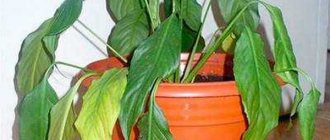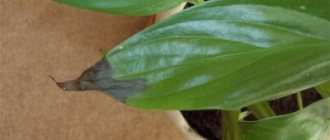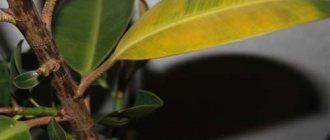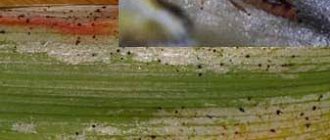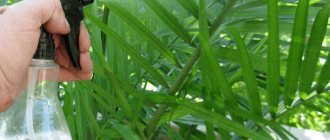Chlorophytum is an evergreen shrub with long saber-shaped leaves.
This flower is very popular among flower growers, as it is absolutely unpretentious and does not require painstaking care.
As a weed, it thrives in both hot and cool conditions. Not afraid of drafts, drought, temperature changes.
Causes of yellowing and drying of leaves of chlorophytum
Almost always, drying and wilting of chlorophytum leaves are a consequence of errors in care:
How to prune Kalanchoe after flowering?
What does the hippeastrum plant look like?
How to grow an orange at home
If the aboveground part of the plant turns pale and then becomes light yellow, it means that the chlorophytum does not have enough lighting or the root system of the flower has grown greatly and the plant does not receive adequate nutrition.
If the lower leaves along their entire length become bright yellow, then the cause may be waterlogging of the soil and, as a consequence, rotting of the root system.
If the tips of the leaves dry out, this indicates insufficient soil moisture or too dry air.
Main reasons
Many gardeners wonder why the leaves of chlorophytum suddenly begin to turn yellow. Most often, a change in foliage color from green to yellow occurs for reasons such as:
- dry air (for example, due to the heating device being turned on);
- the temperature is too high (it should not be higher than 26 degrees);
- incorrectly selected soil mixture, and as a result, a lack of nutrients necessary for the life and growth of the plant;
- a cramped pot, which causes damage to the root system;
- excessive watering, which leads to root rot;
- the presence of various parasitic diseases that lead to yellowness and the appearance of plaque on the leaves.
Luxurious Homemade roses for 147 rubles (advertising)
Ways to solve yellowing of leaves in chlorophytum
Lack of light. This plant loves bright rooms. Usually the flower is placed closer to the windows. If chlorophytum does not have enough light, it immediately begins to lose its green color, its leaves turn yellow and become lethargic.
It is advisable to move the flower pot to a more illuminated place.
In winter, when natural daylight is not enough, use artificial lighting sources;
Lack of nutrition. Chlorophytum needs to be fed throughout the year. In summer, fertilizers are applied frequently, about once a week, in winter less often - once a month;
Cramped pot. "Green Lily" grows quite quickly, especially with careful care. The root system of this flower is quite powerful, so the next time you replant, you need to take the container about 20-30% larger than the previous one in order to provide the roots with enough space to develop.
Why do chlorophytum leaves turn yellow and what to do?
Flower growers may encounter yellowing of the foliage of the flower. The reasons causing this problem and methods to combat them are further in the article.
Did you know? Chlorophytum is useful for people suffering from chronic lung diseases. The plant, absorbing carbon dioxide and other harmful impurities in the air, in return releases phytoncides that destroy pathogenic bacteria.
Dry air
The humidity indicator in a room is not a stable value: in summer, when ventilating, the humidity is much higher than in winter, when heating devices are operating. Due to the dry air, the foliage of chlorophytum begins to turn yellow and dry out.
To avoid this, additional hydration measures are taken:
- spraying and warm shower;
- placing the flowerpot on a tray with wet expanded clay and moss;
- placing wet pieces of fabric on the heating radiator;
- location of decorative fountains nearby;
- use of household humidifiers.
Find out what to do if the tips of the leaves of chlorophytum dry out.
Nutrient deficiency
Under indoor growing conditions, houseplants do not receive enough nutrients, so they need to be fed. For chlorophytum, liquid complexes are used, applying them by root and foliar (by leaves) method 2 times a month (except for the dormant period). It is advisable to purchase commercial fertilizers, since they maintain the balance of substances necessary for growth and flowering:
- nitrogen;
- potassium;
- phosphorus;
- sodium;
- boron.
The following preparations are considered the best compositions for decorative foliage flowerpots:
- "Agricola Aqua";
- "Bona Forte";
- "Etisso".
Important! The cause of yellowing may be excess minerals in the soil. Experienced gardeners recommend cutting the manufacturer's recommended fertilizing dosage in half.
Unsuitable temperature
The recommended storage temperature should not exceed +25°C. Overheating, the plant begins to intensively evaporate moisture, which leads to a change in the structure of cell membranes in the leaves. In summer, the flowerpot feels good on open balconies and terraces, protected from direct sunlight. It is advisable to ventilate the room in order to cool the overheated air naturally.
A sharp drop in temperature due to a draft will be detrimental to the flower if it is kept at temperatures below +10°C on the thermometer. Low temperatures reduce the activity of photosynthesis processes, which causes a change in the color of leaf blades.
In addition, a sharp cold snap leads to disease of the root system, which cannot but affect the color of the foliage. During the dormant period, the recommended temperature for chlorophytum is +12…+18°C.
Root system growth
Chlorophytum has a well-developed root system; spreading out in a tight pot, the roots begin to lift the stems above the soil surface. The flower becomes crowded, and it changes the color of the leaves to yellow.
If the tips of the foliage begin to turn yellow and the roots make their way through the drainage holes, the flowerpot needs to be transplanted into a larger container. Transplantation is carried out in the spring, young specimens - annually, adult bushes - once every 2-3 years. A new container is chosen to be wide, since the fleshy roots grow wider rather than deeper.
Mechanical damage
The green parts of the plant can be damaged during replanting, so it is done using the transshipment method, carefully holding the flower with your free hand.
If there are animals in the house, cats, for example, they can chew the leaves. In this case, you need to remove the damaged plates and treat the sections with crushed activated carbon. If this is not done, bacteria will begin to develop at the site of damage, which will lead not only to discoloration, but also to disease.
Check out these varieties of chlorophytum:
Improper watering
The health of chlorophytum is equally badly affected by a lack of moisture and its excess. When there is a lack of water, the root system stores water, forming thickenings. Nutrients enter the green part in a small volume, which leads to inhibition of photosynthesis processes.
Overmoistening of the soil is fraught with damage to the root system by rot. Diseased roots are not able to transport oxygen, moisture, and nutrition to the rest of the flower.
Yellowing can be caused by excessively hard water, so when watering, you need to let the water sit for about a day. The temperature of the water for irrigation should be the same as the air temperature in the room.
Important! You cannot use cold water for irrigation, otherwise the root system will receive shock from hypothermia.
Diseases and pests
The care errors discussed above often lead to chlorophytum diseases, as well as insect attacks. Main diseases and pests, methods of combating them:
- Root rot - the flowerpot needs to be replanted, removing diseased areas of the roots. They are treated by spraying with Alirin B (2 tablets per liter of water), repeated treatment after a week. If necessary, 3 procedures are performed.
- Bacterial infections (powdery mildew, spotting) - the drug “Gamair” (2 tablets per liter of water) effectively copes with the disease. Carry out 3 treatments, spraying the plant with an interval of 7 days between treatments.
- Thrips and aphids are sucking insects that breed abundantly on indoor flowers. Chlorophytum can be cleaned by mechanically removing insects using a soap solution and a warm shower. After this, the flower must be sprayed with the preparation “Aktara”, the solution is diluted in a proportion of 1 g/1.25 l of water.
- Mealybugs and scale insects also feed on plant sap. You can get rid of them using the drug “Apache”, spraying flowers in a dosage of 0.5 g/1 l of water or by watering the soil in a proportion of 1 g/1 l of water.
- Spider mites - you can fight mites using acaricidal drugs, for example Akarin. The solution is diluted in a ratio of 2 ml/1 l of water.
Watering chlorophytum
The plant prefers constant but moderate moisture. Watering should be done as the soil dries. In summer, 4 times a week, and in winter, depending on the temperature of the plant.
If the temperature does not decrease, then at the same pace. But if the temperature is lower, then you should water several times a week, making sure that there is no stagnation of moisture in the soil.
The plant is unpretentious to indoor air humidity, but it is necessary to spray and take a warm shower once every 30 days. You should not wipe the leaves from dust, since they are quite fragile on the plant.
How to care for chlorophytum at home?
Soil selection
The epiphytic root system will allow the grower not to be tricky with the composition of the soil, but to use a standard mixture. However, the plant will reward you with its beautiful appearance if you make the substrate yourself.
To do this you need to take:
- turf – 3 parts;
- sand (preferably steamed) – 1 part;
- leaf soil (2 parts)
- heat the sand, cool;
- crush the leaf soil;
- mix soil and turf;
- add sand to the mixture and mix well
The soil should be neutral, loose, you can add a little humus.
Selecting a location
An unpretentious bush can thrive in well-lit corridors, near equipment (for example, a computer), and in the kitchen. It should not be placed in drafts, cold window sills or very dry places.
Landing
In order to plant a new plant, you can simply take one of the rosettes, press it to the ground (immediately in the pot) and cover it a little. Nothing else is required, the rosette will take root, putting out new roots, very quickly.
Temperature
The best temperature for summer is from +23 to +27°C. In winter, the temperature can be lowered, the plant will be comfortable at +20°C. At a lower temperature, it is undesirable to torture the flower; it will survive, but will lose its beauty.
Lighting
Of course, chlorophytum can grow in partial shade, but if you place it in the sun, slightly shading it in the hottest time, it will reward you with its beauty. The best lighting for it is a dim, sunny place (for example, an eastern window).
Watering and humidity
For the winter season, very moderate watering (about 2 times a week) is suitable. You can use the weight of the pot as a guide; when it dries, it should become much lighter. In summer, watering follows the usual rules - when the top layer of soil dries out.
Feeding
A standard mineral-organic fertilizer for decorative foliage indoor plants will suit the flower quite well.
Transfer
Spring is the best time to transplant a flower. It is worth choosing a pot according to the size of the plant: a small one may burst under the pressure of powerful roots; too large one will slow down development. When replanting, it is necessary to carefully free the roots from the old soil and, slowly, layer by layer, fill them in a new container with soil prepared in advance.
Fertilizer for chlorophytum
Chlorophytum can be fed with fertilizer for decorative deciduous plants, organic fertilizers or universal fertilizers (“Rainbow”, “Ideal”). There are a lot of companies producing fertilizers. Go to a flower shop; as a rule, the packages will indicate what plants they can be used for. You can choose granular, executioner (“long-lasting”) and liquid fertilizers.
Nutrient deficiencies
Since the plant is constantly in the same soil, the soil is depleted, and it must be fertilized periodically. Complex products for deciduous plants are used as fertilizing; they are applied at the root and on top of the leaves, about twice a month. During the dormant period, that is, in winter, fertilizers are not applied. Complex fertilizers can be purchased in special stores; the product contains a certain amount of necessary substances, sodium, nitrogen, phosphorus, potassium, and other elements. The flower must be removed from direct sunlight, ensure that the soil does not dry out, ventilate the room more often in winter, and take the pot out to the balcony in summer. If the root system has filled the entire container and the chlorophytum is cramped, it is necessary to transplant it into a larger pot.
Chlorophytum transplant
Chlorophytum is replanted every year or two; the best time for this is considered to be February and March. To replant, you need to take a substrate consisting of 1 part leaf soil, one part humus, sand and two parts turf soil. They need to be replanted in spacious flowerpots with good drainage at the bottom. Chlorophytum reproduces by children and division, while the children are simply separated from the peduncle and take root in ordinary soil.
Anthurium male flower: how to care?
Treating apple trees for scab in the fall
Mallow planting seeds in autumn
Reproduction of chlorophytum by lateral shoots
An equally common method for growing chlorophytum at home is the rooting of lateral shoots, the so-called children. This propagation method is simply simple. In addition to beautiful leaves, adult chlorophytum also forms long stems of peduncles, on which daughter rosettes are formed, their appearance resembling the mother plant in “miniature”. This mini bush is ready for planting in the ground immediately after being separated from the stem. But many experienced gardeners recommend first keeping the rosette in a glass of water for several days, and only after the roots become more pronounced, planting them in the ground. The substrate for young plants is prepared in the same way as when dividing a bush. The peculiarity of this method of reproduction is that it is available at any time of the year.
Caring for chlorophytum
As mentioned above, the houseplant chlorophytum does not require intricate care, but at the same time it is difficult to tolerate mistakes. Therefore, the features of how to care for chlorophytum at home should be analyzed in detail.
Lighting
The plant in question is unpretentious in terms of lighting, but it grows better if it stands on the light side - it is better to install flowerpots on the windowsills of the western or eastern side.
When installing it on the north side, there is a lack of lighting, which provokes a loss of decorative function - the color changes for the worse, there is no flowering or layering.
Flowerpots should not be placed on south-facing windows.
Yes, chlorophytum can withstand sunlight for several hours, but constant such exposure is detrimental to the plant.
Temperature
Errors in maintaining temperature do not lead to the death of the plant, but its meager appearance violates the integrity of the decorative composition.
The ideal temperature for a flower is 10-25 °C. It is not difficult to achieve the above indicators; the main thing is to protect the plant from drafts.
Watering
The flower loves watering very much, but it is difficult to choose the average and optimal watering for it.
Firstly, in no case should you over-moisten the soil - this will lead to rotting of the roots, causing the appearance of the leaves to fade, and the flower will gradually die.
Secondly, you should not completely dry out the soil - infrequent watering is permissible only in extreme cases, when it is not possible to moisturize due to circumstances. Excessive drying of the soil will provoke the formation of tuberous thickenings, and if the plant species is not designed for this, it is likely that death will occur.
It is better to keep the soil moist by watering as often as possible, but in small quantities. In the summer, they can be given a warm shower.
Top dressing
The plant should be actively fertilized in the spring and summer; the procedure is carried out twice a month. Here it is important to alternate organic and mineral fertilizers or use combined products for decorative foliage plants.
Transfer
Caring for chlorophytum requires mandatory replanting - it is necessary to update the soil, and for young ones, increase the planting capacity so that the roots can grow and the flower does not die. Replanting is done once every 2 years for an already grown plant in the period from February to March.
Soil for planting
You should pay attention to the soil for planting, which consists of 1 part river sand and 2 parts each of turf, humus, and leaf soil. Drainage must be laid out at the bottom, and the pot itself must be deep and wide.
Diseases and pests of chlorophytum
Chlorophytum can be affected by thrips (see photo above). To prevent the appearance and spread of this pest, it is necessary to maintain a sufficiently high air humidity around the plant and periodically inspect it.
If pests do appear, you need to cut off the affected leaves, dilute the insecticide against aphids according to the instructions, treat the plant, and then repeat the treatment four more times with an interval of 8 days. To prevent these pests from appearing, place several mothballs near the chlorophytum; the smell will repel thrips.

